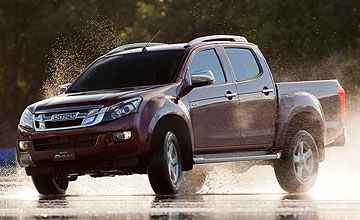BY DAVID HASSALL | 25th Jun 2012

The company claims its new ute – which officially goes on sale from July 2 to coincide with a catchy new TV advertisement – is generally less expensive than its mainstream rivals.
It will be available in five specification levels, including a new range-topper, and three body configurations, with the addition of a space-cab body with reverse-opening ‘wing’ rear doors.
The entry-level 4x2 single-cab-chassis SX model is $210 more expensive than the cheapest version of the related Holden Colorado – the DX model with a 2.5-litre engine – but the more comparable Colorado with a 2.8-litre engine is priced $790 higher.
Isuzu has added a new LS-Terrain 4x4 crew-cab variant as its flagship to cater for the growing lifestyle ute market and claims it will account for between 15 and 20 per cent of Australian sales, which are expected to reach 8000 units by the end of this year – a 5.8 per cent increase on 2011 – and 10,000 next year.
This new LS-Terrain four-wheel-drive flagship is priced at $49,500 with a new five-speed manual transmission or $51,700 with a new five-speed auto, undercutting the new Colorado LTZ by a few hundred dollars while adding satellite-navigation (featuring 10,000 built-in off-road destinations), leather seats and a reversing camera (none of which are available on the Colorado) plus roof rails and electric driver's seat adjustment.
Isuzu Ute Australia managing director Yasuhiro Takeuchi said it made him “very sad” to hear people talk about the previous D-Max as simply a Colorado or Rodeo copy, but believes the new model is sufficiently different to shake that tag and prove “that is not true”.
The new D-Max – the first new ute from Isuzu in a decade – was co-developed with former partner General Motors and therefore is largely similar to the new Colorado, but with a number of significant differences – the front-end styling, the engine and both the manual and automatic transmissions.
It will be sold alongside the outgoing models for the next few months as Isuzu has plenty of remaining stock, having been careful not to leave its dealers without a vehicle to sell in the changeover as the D-Max is the only model Isuzu Ute sells in Australia.
Power from the Euro 4-compliant 3.0-litre turbo-diesel fitted across the range has been lifted 10kW over the superseded model to 130kW at 3600rpm as a result of significant changes, including a new combustion chamber design and intake manifold.
Torque rises 20Nm to 380Nm, peaking between 1800rpm and 3000rpm (2800rpm with the automatic transmission), which the company claims makes it more than a match for the statistically superior 470Nm from the Colorado's Fiat-derived unit.
The redesigned engine provides an improved towing capacity of 2500kg for 4x2 models with a braked trailer and 3000kg for 4x4 models, or 750kg for an unbraked trailer.
It also returns impressively low fuel consumption, with the official combined figures of just 8.1 litres per 100km for vehicles fitted with the efficient new electronically controlled auto and 8.3L/100km for manual models.
Safety was a major consideration in developing and specifying the new D-Max for Australia, so all models come standard with electronic stability control, six airbags, anti-lock brakes with electronic brake-force distribution (which detects payload weight to provide more braking on the rear where necessary) and brake-assist, a new collapsible steering column and brake pedal, and pedestrian impact measures such as an “impact-friendly” front end with recessed fog lights and polycarbonate headlight covers.
Safety has also spelt the end of the farmer-friendly bench seat model (still offered on the outgoing model) because the centre seating position cannot be fitted with a three-point seatbelt.
Despite the focus on safety, however, Isuzu does not offer rear parking sensors at all, even as an accessory, and the reversing camera is only available on the top-end LS-Terrain models because it requires the top-end touch-screen fitted to those models.
Nevertheless, while company officials would not predict what ANCAP safety rating the vehicle might, it clearly expects five stars because it is “aiming for the highest possible score in our class” and both the VW Amarok and Ford Ranger have achieved five-star status.
Other standard features across the range include air-conditioning, power windows, remote central locking, height-adjustable upper mount front seatbelts, front seatbelt pre-tensioners, cruise control, and a new audio system with iPod and Bluetooth connectivity.
Riding on a new ladder-frame chassis that is 45mm longer in the wheelbase (now 3095mm) and provides a 50mm-wider track both front and rear over the old model, the new D-Max is slightly longer than the Toyota HiLux, Nissan Navara, Mitsubishi Triton and even the Amarok.
The extra size provides the new D-Max with extra interior space and larger doors that also open wider, providing improved access. Grip handles attached to the A-pillars further improve access for the driver and front-seat passenger.
Like the Colorado, four-wheel-drive modes can now be selected on-the-fly at up to 100km/h, via a dial in the centre console rather than the previous button operation.
Major service intervals have been extended from 10,000km to 20,000km, due in part to the engine reportedly being designed for reliability and serviceability, such as chain-driven camshafts rather than belts, while the warranty is for three years or 100,000km.